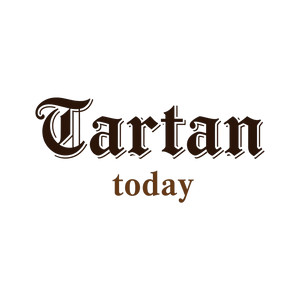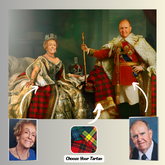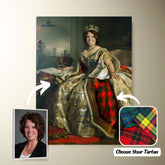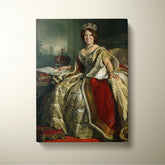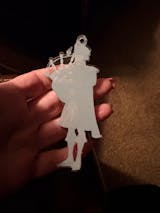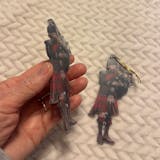-
Personalized Clan Anderson Ancient Tartan Bagpipe Ornament with Custom Name – Scottish Christmas Tree Decoration MN88
Personalized Clan Anderson Ancient Tartan Bagpipe Ornament with Custom Name – Scottish Christmas Tree Decoration MN88Celebrate your Scottish heritage with this unique wood & acrylic tartan ornament. Perfect as a personalized Christmas decoration or a meaningful gift for friends and relatives on special occasions...- From $19.99 USD
$25.99 USD- From $19.99 USD
- Unit price
- per
Save $6.00 -
Personalized Clan Anderson Modern Tartan Bagpipe Ornament with Custom Name – Scottish Christmas Tree Decoration MS44
Personalized Clan Anderson Modern Tartan Bagpipe Ornament with Custom Name – Scottish Christmas Tree Decoration MS44Celebrate your Scottish heritage with this unique wood & acrylic tartan ornament. Perfect as a personalized Christmas decoration or a meaningful gift for friends and relatives on special occasions...- From $19.99 USD
$25.99 USD- From $19.99 USD
- Unit price
- per
Save $6.00 -
Clan Anderson Family Tartan 2D T-shirt KV88 - Black
Anderson Family Tartan Clan 2D T-shirt KV88 Product detail: This new 2D t-shirt features a relaxed fit for Men and Women, durable, breathable and soft Made from 100% cotton The High-resolution graphic artwork is printed on the entire shirt. Machine wash cold. The print...- $29.25 USD
- $29.25 USD
- Unit price
- per
-
Black
-
White
-
Navy
-
Storm Grey
-
Personalized Clan Anderson of Arbrake Tartan Bagpipe Ornament with Custom Name – Scottish Christmas Tree Decoration SN79
Personalized Clan Anderson of Arbrake Tartan Bagpipe Ornament with Custom Name – Scottish Christmas Tree Decoration SN79Celebrate your Scottish heritage with this unique wood & acrylic tartan ornament. Perfect as a personalized Christmas decoration or a meaningful gift for friends and relatives on special...- From $19.99 USD
$25.99 USD- From $19.99 USD
- Unit price
- per
Save $6.00 -
Clan Anderson Ancient Tartan Saddle Handbags GF49 - Anderson Ancient Tartan Clan
Anderson Ancient Tartan Clan Saddle Handbags GF49 Product Detail: Manufactured with premium water-proof canvas material. Features a comfortable and sturdy adjustable cross-body carrying strap made with leather and high-quality stitching for long-lasting durability. Finished with multiple interior compartments to keep your items organized.- $55.15 USD
- $55.15 USD
- Unit price
- per
-
Anderson Ancient Tartan Clan
-
Personalized Clan Anderson Grey Modern Tartan Bagpipe Ornament with Custom Name – Scottish Christmas Tree Decoration DR47
Personalized Clan Anderson Grey Modern Tartan Bagpipe Ornament with Custom Name – Scottish Christmas Tree Decoration DR47Celebrate your Scottish heritage with this unique wood & acrylic tartan ornament. Perfect as a personalized Christmas decoration or a meaningful gift for friends and relatives on special...- From $19.99 USD
$25.99 USD- From $19.99 USD
- Unit price
- per
Save $6.00 -
Personalized Clan Anderson Blue Westwood Ancient Tartan Santa Ornament – Custom Acrylic Christmas Decoration GO24 - Anderson
Personalized Clan Anderson Blue Westwood Ancient Tartan Ornament – Custom Acrylic Christmas Decoration GO24Celebrate your Scottish heritage with this unique wood & acrylic tartan ornament. Perfect as a personalized Christmas decoration or a meaningful gift for friends and relatives on special occasions such as...- From $19.99 USD
- From $19.99 USD
- Unit price
- per
-
Anderson
-
Personalized Clan Anderson Ancient Clan Crest Tartan Santa Ornament – Custom Acrylic Christmas Decoration YA91 - Anderson
Personalized Clan Anderson Ancient Clan Badge Tartan Ornament – Custom Acrylic Christmas Decoration YA91Celebrate your Scottish heritage with this unique wood & acrylic tartan ornament. Perfect as a personalized Christmas decoration or a meaningful gift for friends and relatives on special occasions such as...- From $19.99 USD
- From $19.99 USD
- Unit price
- per
-
Anderson
-
Clan Anderson Ancient Tartan Christmas Ceramic Ornament Highland Cows Style DS97 - Anderson Ancient Tartan
Clan Anderson Ancient Tartan Christmas Ceramic Ornament Highland Cows Style DS97 Product Detail:One of the best things about Christmas is that it gives you an excuse to dress up your home with all of the lovely ornaments we associate with the holiday season. With...- From $14.45 USD
- From $14.45 USD
- Unit price
- per
-
Anderson Ancient Tartan
-
Clan Anderson Modern Tartan Hoodie Crest XA8TBJMS-1 - Anderson Modern
Anderson Modern Tartan Clan Hoodie Crest XA8TBJMS-1 Details: Our 95% polyester and 5% spandex hoodies produce high-quality thermal-transfer printed products that keep you comfortable, cool, and dry while you work and play. The use of high-tech graphic prints on hoodies, as well as vibrant...- $57.25 USD
- $57.25 USD
- Unit price
- per
-
Anderson Modern
-
Clan Anderson Modern Tartan Crest Garden Flag - Welcome TU79 - Anderson Modern Tartan Clan
Anderson Modern Tartan Clan Crest Garden Flag - Welcome TU79 Product Detail: Welcome guests to your home with this seasonal flag. Available in 2 sizes: Small size 12'x18' and Large size 28'x40' Material: 100% polyester, PU and carbon black. Weatherproof and fade resistant fabric...- $35.45 USD
- $35.45 USD
- Unit price
- per
-
Anderson Modern Tartan Clan
-
Clan Anderson Modern Tartan Crest Black Garden Flag - Gold Thistle NC64 - Anderson Modern Tartan Clan
Anderson Modern Tartan Clan Crest Black Garden Flag - Gold Thistle NC64 Product Detail: Welcome guests to your home with this seasonal flag. Available in 2 sizes: Small size 12'x18' and Large size 28'x40' Material: 100% polyester, PU and carbon black. Weatherproof and fade...- $35.45 USD
- $35.45 USD
- Unit price
- per
-
Anderson Modern Tartan Clan
-
Clan Anderson Ancient Tartan Crest Garden Flag - Celtic Thistle OK84 - Anderson Ancient Tartan Clan
Anderson Ancient Tartan Clan Crest Garden Flag - Celtic Thistle OK84 Product Detail: Welcome guests to your home with this seasonal flag. Available in 2 sizes: Small size 12'x18' and Large size 28'x40' Material: 100% polyester, PU and carbon black. Weatherproof and fade resistant...- $35.45 USD
- $35.45 USD
- Unit price
- per
-
Anderson Ancient Tartan Clan
-
Clan Anderson Modern Tartan Crest Blanket Wave Style YU51 - Anderson Modern Tartan Clan
Anderson Modern Tartan Clan Crest Blanket Wave Style YU51 Product Detail: Each blanket features a premium suede polyester print for beautiful color vibrancy. Cozy underside is constructed from an ultra-soft micro fleece fabric to keep you warm and comfortable. Perfect for snuggling while watching...- $65.02 USD
- $65.02 USD
- Unit price
- per
-
Anderson Modern Tartan Clan
-
Personalized Clan Anderson of Arbrake Tartan Drummer Ornament with Custom Name – Scottish Christmas Tree Decoration GC69
Personalized Clan Anderson of Arbrake Tartan Drummer Ornament with Custom Name – Scottish Christmas Tree Decoration GC69Celebrate your Scottish heritage with this unique wood & acrylic tartan ornament. Perfect as a personalized Christmas decoration or a meaningful gift for friends and relatives on special...- From $19.99 USD
$25.99 USD- From $19.99 USD
- Unit price
- per
Save $6.00 -
Personalized Clan Anderson Modern Tartan Drummer Ornament with Custom Name – Scottish Christmas Tree Decoration VX64
Personalized Clan Anderson Modern Tartan Drummer Ornament with Custom Name – Scottish Christmas Tree Decoration VX64Celebrate your Scottish heritage with this unique wood & acrylic tartan ornament. Perfect as a personalized Christmas decoration or a meaningful gift for friends and relatives on special occasions...- From $19.99 USD
$25.99 USD- From $19.99 USD
- Unit price
- per
Save $6.00 -
Personalized Clan Anderson Ancient Tartan Drummer Ornament with Custom Name – Scottish Christmas Tree Decoration OC43
Personalized Clan Anderson Ancient Tartan Drummer Ornament with Custom Name – Scottish Christmas Tree Decoration OC43Celebrate your Scottish heritage with this unique wood & acrylic tartan ornament. Perfect as a personalized Christmas decoration or a meaningful gift for friends and relatives on special occasions...- From $19.99 USD
$25.99 USD- From $19.99 USD
- Unit price
- per
Save $6.00 -
Personalized Clan Manderson #2 Reproduction Tartan Bagpipe Ornament with Custom Name – Scottish Christmas Tree Decoration RV84
Personalized Clan Manderson #2 Reproduction Tartan Bagpipe Ornament with Custom Name – Scottish Christmas Tree Decoration RV84Celebrate your Scottish heritage with this unique wood & acrylic tartan ornament. Perfect as a personalized Christmas decoration or a meaningful gift for friends and relatives on special...- From $19.99 USD
$25.99 USD- From $19.99 USD
- Unit price
- per
Save $6.00 -
Personalized Clan Manderson #2 Modern Tartan Bagpipe Ornament with Custom Name – Scottish Christmas Tree Decoration WA28
Personalized Clan Manderson #2 Modern Tartan Bagpipe Ornament with Custom Name – Scottish Christmas Tree Decoration WA28Celebrate your Scottish heritage with this unique wood & acrylic tartan ornament. Perfect as a personalized Christmas decoration or a meaningful gift for friends and relatives on special...- From $19.99 USD
$25.99 USD- From $19.99 USD
- Unit price
- per
Save $6.00 -
Personalized Clan Manderson #2 Ancient Tartan Bagpipe Ornament with Custom Name – Scottish Christmas Tree Decoration FA90
Personalized Clan Manderson #2 Ancient Tartan Bagpipe Ornament with Custom Name – Scottish Christmas Tree Decoration FA90Celebrate your Scottish heritage with this unique wood & acrylic tartan ornament. Perfect as a personalized Christmas decoration or a meaningful gift for friends and relatives on special...- From $19.99 USD
$25.99 USD- From $19.99 USD
- Unit price
- per
Save $6.00
Ex: Your Tartan + Product
Popular Products
Turn Me Royal Personalized Portrait from Your Photo, Custom Tartan. Custom Canvas Wall Art as Gift for Men
- From $32.45 USD
- From $32.45 USD
- Unit price
- / per
Royalty Couple Personalized Portrait from Your Photo, Custom Tartan. Custom Canvas Wall Art
- From $47.45 USD
- From $47.45 USD
- Unit price
- / per
The Queen Personalized Portrait from Your Photo, Custom Tartan. Custom Canvas Wall Art as Gift for Women
- From $32.45 USD
- From $32.45 USD
- Unit price
- / per
Which Clan Are You From?
- Anderson
- Anderson 01
- Anderson 02
- Anderson 03
- Anderson Ancient
- Anderson Ancient Gnome
- Anderson Ancient Tartan
- Anderson Arisaid #2 Ancient
- Anderson Arisaid #2 Modern
- Anderson Arisaid #2 Reproduction
- Anderson Arisaid Ancient
- Anderson Arisaid Modern
- Anderson Arisaid Reproduction
- Anderson Blue Ancient
- Anderson Blue Modern
- Anderson Blue Reproduction
- Anderson Blue Weathered
- Anderson Blue Westwood Ancient
- Anderson Blue Westwood Modern
- Anderson Blue Westwood Weathered
- Anderson clanAnderson tartanApron
- Anderson clanAnderson tartanPillow Cover
- Anderson Coulson Bonner 01
- Anderson Coulson Bonner 02
- Anderson Dress
- Anderson Green Ancient
- Anderson Green Modern
- Anderson Green Reproduction
- Anderson Grey Ancient
- Anderson Grey Modern
- Anderson Grey Reproduction
- Anderson Highland Society Of London
- Anderson Highland Society of London Modern
- Anderson MacGregor Hastie 01
- Anderson MacGregor Hastie 02
- Anderson MacGregor Hastie 03
- Anderson Modern
- Anderson Modern Gnome
- Anderson Modern Tartan
- Anderson Muted
- Anderson of Arbrake
- Anderson of Arbrake Gnome
- Anderson of Arbrake Tartan
- Anderson Of Ardbrake
- Anderson of Ardbrake Ancient
- Anderson of Ardbrake Modern
- Anderson of Ardbrake Reproduction
- Anderson of Ardbrake Weathered
- Anderson of Kinneddar Hunting
- Anderson of Kinneddar Hunting Ancient
- Anderson of Kinneddar Hunting Modern
- Anderson of Kinneddar Hunting Reproduction
- Anderson of Kinneddar Hunting Weathered
- Anderson of Kinneddar Red Ancient
- Anderson of Kinneddar Red Modern
- Anderson of Kinneddar Red Reproduction
- Anderson of Kinneddar Red Weathered
- Anderson of Kinnedear Red
- Anderson Old Ancient
- Anderson Old Makinlay
- Anderson Old Modern
- Anderson Old Reproduction
- Anderson Old Weathered
- Anderson Paton
- Anderson Red
- Anderson Red Ancient
- Anderson Red Modern
- Anderson Red Reproduction
- Anderson Red Weathered
- Anderson Reproduction
- Anderson Ross Ancient
- Anderson Ross Modern
- Anderson Ross Reproduction
- Anderson Ross Weathered
- Anderson STS
- Anderson Tartan
- Anderson W L
- Anderson Weathered
- Don
- MacDougall
- MacDougall Kinloch Anderson
- MacGregor
- Manderson #2 Ancient
- Manderson #2 Modern
- Manderson #2 Reproduction
- Scott
List Of Tartan
-
Clan A
- Abercrombie Tartan
- Aberdeen Tartan
- Abernethy Tartan
- Adair Tartan
- Adam Tartan
- Ayrshire Tartan
- Agnew Tartan
- Aikenhead Tartan
- Ainslie Tartan
- Aiton Tartan
- Allan Tartan
- Alexander Tartan
- Allardice Tartan
- Allison Tartan
- Anderson Tartan
- Angus Tartan
- Anstruther Tartan
- Arbuthnot Tartan
- Armstrong Tartan
- Arnott Tartan
- Auchinleck Tartan
- Ayrshire Tartan
-
Clan B
- Baillie Tartan
- Bain Tartan
- Baird Tartan
- Balfour Tartan
- Bannatyne Tartan
- Bannerman Tartan
- Barclay Tartan
- Baxter Tartan
- Beaton Tartan
- Bell Tartan
- Belshes Tartan
- Bethune Tartan
- Beveridge Tartan
- Binning Tartan
- Bisset Tartan
- Blackadder Tartan
- Blackstock Tartan
- Black Watch Tartan
- Blair Tartan
- Blane Tartan
- Blyth Tartan
- Borthwick Tartan
- Boswell Tartan
- Bowie Tartan
- Boyd Tartan
- Boyle Tartan
- Brisbane Tartan
- Brodie Tartan
- Brown/ Broun Tartan
- Bruce Tartan
- Buccleuch Tartan
- Buchan Tartan
- Buchanan Tartan
- Burnett Tartan
- Burns Tartan
- Butter Tartan
- Byres Tartan
-
Clan C
- Cairns Tartan
- Calder Tartan
- Callander Tartan
- Cameron Tartan
- Campbell Tartan
- Campbell of Breadalbane Tartan
- Campbell of Cawdor Tartan
- Carmichael Tartan
- Carnegie Tartan
- Carruthers Tartan
- Cathcart Tartan
- Chalmers Tartan
- Charteris Tartan
- Chattan Tartan
- Cheyne Tartan
- Chisholm Tartan
- Christie Tartan
- Clark Tartan
- Clelland Tartan
- Clephan Tartan
- Clergy Tartan
- Cochrane Tartan
- Cockburn Tartan
- Colquhoun Tartan
- Colville Tartan
- Cooper Tartan
- Couper Tartan
- Craig Tartan
- Cranstoun Tartan
- Crawford Tartan
- Crichton Tartan
- Crief District Tartan
- Crosbie Tartan
- Cumming Tartan
- Cunningham Tartan
- Currie Tartan
- Clan D
- Clan E
- Clan F
- Clan G
- Clan H
- Clan I
- Clan J
- Clan K
- Clan L
-
Clan M
- Maitland Tartan
- Malcolm Tartan
- Mar Tartan
- Marjoribanks Tartan
- Maxtone Tartan
- Matheson Tartan
- Maule Tartan
- Maxwell Tartan
- Meldrum Tartan
- Melville Tartan
- Menzies Tartan
- Mercer Tartan
- Middleton Tartan
- Moffat Tartan
- Moncrieffe Tartan
- Montgomery Tartan
- Monypenny Tartan
- Moncreiffe Tartan
- Monteith Tartan
- Morrison Tartan
- Mouat Tartan
- Moubray Tartan
- Mow Tartan
- Muir_More Tartan
- Muirhead Tartan
- Munro Tartan
- Murray Tartan
- Murray of Atholl Tartan
-
Clan Mc/Mac
- MacAlister Tartan
- MacArthur Tartan
- MacAlpine Tartan
- MacAulay Tartan
- MacBain Tartan
- MacBean Tartan
- MacBeth Tartan
- MacCallum Tartan
- MacCraig Tartan
- MacColl Tartan
- MacCorquodale Tartan
- MacDiarmid Tartan
- MacDonald Tartan
- MacDonald of Clanranald Tartan
- MacDonald of Sleat Tartan
- MacDonnell of Glengarry Tartan
- MacDonnell of Keppoch Tartan
- MacDougall Tartan
- MacDowall Tartan
- MacDuff Tartan
- MacEwen_MacEwan Tartan
- MacEdward Tartan
- MacFarlane Tartan
- MacGill Tartan
- MacGillivray Tartan
- MacGregor Tartan
- MacGowan (McGowan) Tartan
- MacHardy Tartan
- MacIan Tartan
- MacInnes Tartan
- MacIntyre Tartan
- MacKay Tartan
- MacKillop Tartan
- MacKellar Tartan
- Mackinlay Tartan
- MacKenzie Tartan
- Mackie Tartan
- MacKinnon Tartan
- MacKintosh / MacIntosh Tartan
- MacLeod Tartan
- MacMillan Tartan
- MacNab Tartan
- MacNaughton Tartan
- MacNeil / MacNeill Tartan
- MacNeil of Colonsay Tartan
- MacNicol Tartan
- MacPhail Tartan
- MacPhee_MacFie Tartan
- MacPherson Tartan
- MacQuarrie Tartan
- MacQueen Tartan
- MacRae Tartan
- MacRow Tartan
- MacSporran Tartan
- MacTaggart Tartan
- MacTavish Tartan
- MacThomas Tartan
- McCorquodale Tartan
- McCulloch Tartan
- McFadzen Tartan
- McGeachie Tartan
- McIver Tartan
- McKerrell Tartan
- Clan N
- Clan O
- Clan P
- Clan R
-
Clan S
- Sandilands Tartan
- Scott Tartan
- Scrymgeour Tartan
- Selkirk Tartan
- Sempill Tartan
- Seton Tartan
- Shaw Tartan
- Shepherd Tartan
- Sinclair Tartan
- Skene Tartan
- Skirving Tartan
- Smith Tartan
- Somerville Tartan
- Spalding Tartan
- Spens Tartan
- Spottiswood Tartan
- Stevenson Tartan
- Stewart Tartan
- Stewart of Appin Tartan
- Stirling Tartan
- Strachan Tartan
- Straiton Tartan
- Strange Tartan
- Strathclyde District Tartan
- Stuart of Bute Tartan
- Sutherland Tartan
- Swinton Tartan
- Clan T
- Clan U W Y
- Request Your Clan
Clan Anderson (Anderson Tartan)
1. Clan Anderson History (Anderson Tartan)
Scotland is home to several people who go by the name "son of Andrew" in various versions. Anderson was more frequently used in the lowlands while MacAndrew was used in the Highlands.

They both derive from the same Gaelic word, Gilleaindreas, which means "servant of St. Andrew," the patron saint of Scotland.
Although it is said that there is no specific origin, the Kinrara manuscript offers information about the claim that the MacAndrews arrived in Badenoch from Moidart around 1400.
Perhaps this is confirmed by stories about Iain Beg MacAindrea's retaliation against livestock rustlers who ravaged Badenoch. The intellectual legacy that his family members afterwards established, however, cannot be contested.
In the history of the Anderson clan in all professions, the tradition of academic erudition has deep roots. Alexander Anderson, who produced texts on algebra and geometry in Paris between 1612 and 1619, is credited with founding this custom.
Similar mechanical and mathematical abilities were shared by his relative David Anderson of Finshaugh, who used them to clear the entrance to Aberdeen port of a sizable boulder.
His accomplishment earned him the moniker "Davie-Do-a-Things."
2. Clan Anderson Tartans
Anderson Ancient
Anderson Modern
Anderson Weathered
3. Clan Anderson Crest & Coats of Arms
3.1 Clan Anderson Crest
Worn by all of the name and ancestry.

An oak tree, Proper
3.2 Clan Anderson Coats of Arms
A note on Coats of Arms:
With the exception of civic or corporate arms, a person is granted a coat of arms under Scottish heraldic law. A 'family coat of arms' does not exist.
With the exclusions listed above, the weapons depicted below are personal weapons. The only person authorized to use these weapons is the grantee.


Anderson Arms


Different Anderson branch arms
4. Clan Anderson People & Places
4.1 Clan Anderson Places
The Anderson family received the estates and lairdship of Candacraig in Aberdeenshire in 1620; it stayed in the family for 246 years, until 1866.

4.2 Clan Anderson People

4.2.1 Adam Anderson (1692 or 1693-1765)
Scotsman Adam Anderson was an economist. Written on his experience as one of the trustees who formed the colony of Georgia under the charter granted to General Oglethorpe in 1732, he produced a scientific study of the "Historical and Chronological Deduction of the Origin of Commerce" in 1765.
4.2.2 James Anderson (1739-1808)
Political economist and agriculturalist James Anderson, FRSE, FSAScot. His "Account of the Present State of The Hebrides and Western Coasts of Scotland" was written in 1785, and he also contributed the entry "Monsoon" to the first Encyclopaedia Britannica in 1773, which correctly foretold the discoveries Captain Cook would make before his return.

4.2.3 John Anderson (1726 – 1796)
At Glasgow University, John Anderson, FRSE FRS FSA(Scot), taught natural philosophy. The fact that his "Institutes of Physics" saw five editions during his lifetime speaks much about the caliber of his scholarly output.
By developing a technique for reducing cannon recoil that was favorably embraced by the French National Convention in 1791, he continued the relationship with France that his ancestor Alexander had begun in the seventeenth century.

4.2.4 William Anderson (1805-1866)
Produced "The Scottish Nation," a well-known three-volume biographical history of the Scottish people, in 1863.

4.2.5 John Anderson (1882 – 1958)
He was born in Edinburgh and served as Bengal's remarkable governor from 1932 to 1937, which marked India's crucial transition out of the British Empire.
Viscount Waverly, the last independent member of the British Parliament, also created the Anderson bomb shelter while serving in Churchill's government.

7. Unveiling the Enigmatic Clan Anderson: A Tale of Tradition and Legacy
Immerse yourself in the captivating world of Clan Anderson, an ancient Scottish clan with a remarkable history. Despite not having a recognized chief, this armigerous clan leaves a lasting impression due to its strong connections with other esteemed clans.
In this article, we will explore the origins of the surname "Anderson" and its significance as the son of Andrew.
We will delve into the clan's eventful past, from notable members who made significant contributions to society to the challenges faced during the Highland Clearances.
Discover how Clan Anderson continues to maintain its sense of kinship and pride through its society and genealogical records. Step into the mysterious Clan Anderson, where the ancient Tartan weaves together a sense of belonging and heritage.
8. Origins of the Anderson Surname
The Anderson surname has deep roots in Scottish history, with its origins dating back to the 13th century.
The name Anderson is derived from the patronymic form of the name Andrew, meaning "son of Andrew."
It is a common practice in Scottish naming conventions to use this form to denote lineage and descent. The Andersons, therefore, are known as the Sons of Andrew.
9. The Anderson Clan: A History of Bravery and Resilience
9.1 Renowned Archers and Cattle Thieves
The Anderson clan has a proud history of renowned archers, known for their exceptional skill with the bow and arrow.
These archers played a crucial role in defending their lands and combating cattle thieves, who posed a constant threat to their livelihoods.
Tales of their bravery and resilience in the face of adversity are still recounted today, highlighting the indomitable spirit of the Anderson clan.
9.2 Notable Members and Contributions to Society
Over the centuries, the Anderson clan has produced several notable members who have made significant contributions to society.
From scholars and artists to military leaders and politicians, the Andersons have left their mark in various fields.
One such individual is Sir Robert Anderson, a renowned Scottish barrister and writer who served as a senior police official in London during the late 19th century.
His work in the field of criminology and his contributions to the study of Jack the Ripper's case have earned him a place in history.
9.3 Challenges Faced during the Highland Clearances
Like many other Scottish clans, the Andersons faced significant challenges during the Highland Clearances.
These were a series of forced evictions and relocations of Highlanders by landlords, primarily to make way for large-scale sheep farming.
The Andersons, deeply connected to their ancestral lands, often found themselves displaced and struggling to maintain their way of life.
Despite these hardships, the Anderson clan persevered and adapted, holding onto their traditions and heritage.
10. Clan Anderson: A Tightly Knit Community
Although the Clan Anderson is currently armigerous, lacking a recognized chief, it remains a tightly knit community.
The clan is governed by a council comprising esteemed members who ensure the smooth functioning of the clan's activities and maintain its sense of kinship.
This close-knit nature fosters a strong sense of belonging and solidarity among the members of Clan Anderson.
11. Preserving the Clan's Heritage: Society and Genealogical Records
To maintain its rich history and sense of kinship, Clan Anderson has established a society dedicated to preserving the clan's heritage.
This society acts as a central hub for clan members to connect, share stories, and delve deeper into their ancestral roots.
Additionally, the clan maintains comprehensive genealogical records, allowing members to trace their lineage and understand their place within the larger clan.
12. The Anderson Tartan: A Rich History and Unique Design
12.1 The Anderson Tartan: Symbol of Scottish Heritage
Embark on a journey through the captivating realm of the Anderson Tartan, a symbol of Scottish heritage.
The Andersons, also known as the Sons of Andrew, possess an intriguing past and a tartan that stands apart from the rest.
With its distinctive light blue background and seven vibrant colors, this tartan is truly one-of-a-kind.
12.2 Deep Scottish Roots: A Tartan Steeped in Tradition
The Anderson Tartan represents the Anderson family, which boasts deep Scottish roots dating back to the 13th century.
The tartan's design incorporates colors and patterns that are significant to the clan's history and traditions, making it a cherished symbol of their heritage.
Wearing the Anderson Tartan, therefore, is not only a fashion statement but also a way of paying homage to one's Scottish ancestry.
12.3 Kinloch Anderson: Crafting Impeccable Anderson Tartan Products
The Anderson Tartan is highly coveted in the realm of Highland dress. Kinloch Anderson, a renowned Scottish textiles company, provides impeccable products crafted with precision and attention to detail.
From kilts and scarves to rugs and accessories, each piece featuring the Anderson Tartan is a testament to the clan's rich history and unique design.
12.4 The Intricate Pattern of the Anderson Tartan
The Anderson Tartan's intricate pattern is a result of its unique origins in the early 19th century. It incorporates elements of older tartan designs while also introducing variation in the sett.
The use of seven vibrant colors against the light blue background creates a visually striking and harmonious combination that sets the Anderson Tartan apart from others.
13. Embracing Tradition and Resilience: The Anderson Tartan's Symbolism
Whether you are a proud member of Clan Anderson or simply drawn to its captivating design, the Anderson Tartan serves as a symbol of tradition, resilience, and honor.
It is a reminder of the enduring spirit of the Sons of Andrew, who have overcome challenges and preserved their heritage through the generations.
Embrace this rich Scottish heritage and proudly don the Anderson Tartan to connect with the profound legacy of Clan Anderson.
14. Frequently Asked Questions (FAQs)
14.1 What is the significance of the Anderson Tartan?
The Anderson Tartan holds great significance as it represents the Anderson family, who have deep Scottish roots and a proud history. Wearing the tartan is a way of honoring one's Scottish heritage and connecting with the traditions of the Sons of Andrew.
14.2 Can anyone wear the Anderson Tartan?
Yes, anyone can wear the Anderson Tartan. Whether you are a member of Clan Anderson or simply appreciate its unique design, wearing the tartan is a statement of pride in Scottish heritage and a celebration of tradition.
14.3 How can I trace my lineage within Clan Anderson?
Clan Anderson maintains comprehensive genealogical records, which can help members trace their lineage and understand their place within the larger clan.
By reaching out to the clan's society and utilizing these resources, individuals can delve deeper into their ancestral roots and connect with their Anderson heritage.
14.4 What is the role of the Clan Anderson society?
The Clan Anderson society plays a vital role in preserving the clan's heritage and fostering a sense of kinship among its members.
It provides a platform for clan members to connect, share stories, and delve deeper into their ancestral roots, ensuring the enduring legacy of Clan Anderson.
14.5 Are there any notable members of Clan Anderson?
Yes, Clan Anderson has produced several notable members who have made significant contributions to society.
One such example is Sir Robert Anderson, a renowned Scottish barrister and writer who served as a senior police official in London during the late 19th century.
His work in the field of criminology and his contributions to the study of Jack the Ripper's case have earned him a place in history.
14.6 How can I obtain Anderson Tartan products?
Kinloch Anderson, a renowned Scottish textiles company, provides a wide range of Anderson Tartan products, including kilts, scarves, rugs, and accessories.
These products are crafted with precision and attention to detail, ensuring impeccable quality and authenticity.
15. Conclusion
In the captivating world of Clan Anderson, tradition and resilience intertwine to create a sense of kinship and pride. Despite not having a recognized chief, this armigerous clan leaves a lasting impression due to its strong connections with other esteemed clans.
The Anderson Tartan, with its rich history and unique design, serves as a symbol of Scottish heritage and the enduring spirit of the Sons of Andrew.
Whether you proudly wear the tartan or simply appreciate its beauty, embracing the Anderson Tartan allows you to connect with the profound legacy of Clan Anderson and carry on its traditions for generations to come.
- Choosing a selection results in a full page refresh.
